Hey all. Today is graduation day! Tune in at 10 to watch the ceremony live.
Plated
 It seems like dessert is the hardest thing to sell at a restaurant. Aside from suffering from its position at the end of a meal, after everyone has had their fill, dessert really needs to impress to get noticed by customers. It’s easy to pass up dime-dozen confections like ice cream sundaes and molten chocolate cake, but when a restaurant makes the effort to create an edible art piece, it is far more likely to simultaneously drive people to order, and enhance their experience.
It seems like dessert is the hardest thing to sell at a restaurant. Aside from suffering from its position at the end of a meal, after everyone has had their fill, dessert really needs to impress to get noticed by customers. It’s easy to pass up dime-dozen confections like ice cream sundaes and molten chocolate cake, but when a restaurant makes the effort to create an edible art piece, it is far more likely to simultaneously drive people to order, and enhance their experience.
 Restaurant Production Desserts was my second to last class (and really the last “traditional class”) before graduation. As our roster has fallen to a low total of seven students, we were faced with the challenge of approaching production as individuals, rather than teams, as was the usual format of the class.
Restaurant Production Desserts was my second to last class (and really the last “traditional class”) before graduation. As our roster has fallen to a low total of seven students, we were faced with the challenge of approaching production as individuals, rather than teams, as was the usual format of the class.
The first couple of days had their obstacles to overcome. At this point in our education, we had been out of the bakeshop for nine weeks, and it took a little bit of time to get back into the swing of things. Flying solo meant we had to produce at a pace that many of us were not accustomed to. To make up for the increase in our production load we were only required to have a finished composition every two days, rather than every day. Even with that altered schedule, it was still a challenge to finish all the components for each dessert, and required we work with haste. We each completed 3 desserts before the production of our final projects.
 For the final, we were given free reign to produce a plated dessert. We had control over everything from flavor, to components, to plating. This was really the first time we were given complete creative control on a project. I chose to produce a dessert inspired by Thai cuisine, consisting of a mango-curry mousse, atop a coconut sable cookie base, with basil chantilly cream, peanut tuile, peanut praline, mango sauce, basil sauce, and a lime sorbet. We then served our creations at our final open showcase at The CIA.
For the final, we were given free reign to produce a plated dessert. We had control over everything from flavor, to components, to plating. This was really the first time we were given complete creative control on a project. I chose to produce a dessert inspired by Thai cuisine, consisting of a mango-curry mousse, atop a coconut sable cookie base, with basil chantilly cream, peanut tuile, peanut praline, mango sauce, basil sauce, and a lime sorbet. We then served our creations at our final open showcase at The CIA.
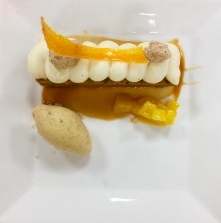 This class was certainly a challenge, but it was a great introduction to an incredibly important part of the restaurant culinary experience. As our next and final class has us plating desserts in the on campus restaurants, it was certainly great practice for what is sure to be an exciting finale. Only three more weeks to go!
This class was certainly a challenge, but it was a great introduction to an incredibly important part of the restaurant culinary experience. As our next and final class has us plating desserts in the on campus restaurants, it was certainly great practice for what is sure to be an exciting finale. Only three more weeks to go!
Work The Line
 I’ve never been one for change, but sometimes in life, there are things you just have to do. When I entered the Baking & Pastry Arts program at the CIA, I was excited to eventually spend some time working in the Apple Pie Bakery and Café. It was sort of a “right of passage,” a final step before the last push towards graduation. Unfortunately, the CIA decided to renovate it a mere weeks before my start date. With nowhere to go, we were forced into the kitchen at Post Road Brew House, with the majority of us being placed onto the line cooking savory food.
I’ve never been one for change, but sometimes in life, there are things you just have to do. When I entered the Baking & Pastry Arts program at the CIA, I was excited to eventually spend some time working in the Apple Pie Bakery and Café. It was sort of a “right of passage,” a final step before the last push towards graduation. Unfortunately, the CIA decided to renovate it a mere weeks before my start date. With nowhere to go, we were forced into the kitchen at Post Road Brew House, with the majority of us being placed onto the line cooking savory food.
When we first found out about the change, I was…..upset. The keyword here being “was”. Although there were savory positions at The Apple Pie, it being a café allowed far more opportunities for baking. The Brew House on the other hand, is full on pub, limiting the pastry positions to the few students who get to plate desserts. The limited opportunities were only made worse by my small class size, which has fallen to a miniscule seven students. This meant that any hands that could be spared were needed on the line to cook food for the restaurant.
 With the exception of the three weeks we spent in our Café Savory course, the majority of us had no experience in a savory kitchen. That class was only really a broad overview of culinary techniques anyway. To say I was upset was an understatement.
With the exception of the three weeks we spent in our Café Savory course, the majority of us had no experience in a savory kitchen. That class was only really a broad overview of culinary techniques anyway. To say I was upset was an understatement.
Having not yet recovered from the stress that was my wines class, I started off on a bad note, tired, cranky, sore, and unnerved. The days ran from 6am to 4pm, and by the end of the day, I felt every second of it. I was able to choose the Garde Mange station, escaping the hot side of the kitchen. The intensity of it still made me break a sweat, as I prepared the main course and appetizer salads. After the first day, I honestly didn’t think I would make it through. I felt defeated, and considered withdrawing until the re-opening of The Apple Pie Bakery, but after a few days, things balanced out.
 I found my rhythm. The kitchen is a very different beast than the bakeshop and I really just needed to take the time to get used to it. Where as the bakeshop is refined, quiet, and orderly, the kitchen is…….more energetic. It’s loud and ever changing. People have fun with each other, hurling jokes back and forth and often times yelling complete nonsense for the sake of it. Different permutations of our call back “Oui” have now become inside jokes within (and outside) the kitchen. We have managed to get a taste of what our culinary classmates experience on a daily basis.
I found my rhythm. The kitchen is a very different beast than the bakeshop and I really just needed to take the time to get used to it. Where as the bakeshop is refined, quiet, and orderly, the kitchen is…….more energetic. It’s loud and ever changing. People have fun with each other, hurling jokes back and forth and often times yelling complete nonsense for the sake of it. Different permutations of our call back “Oui” have now become inside jokes within (and outside) the kitchen. We have managed to get a taste of what our culinary classmates experience on a daily basis.
After talking to the Chef on day one, she said that although I may hate it now, I’d be missing it by the end. She wasn’t wrong. Although it wasn’t the experience I had been looking forward to, it wound up being something that will likely prove to be more beneficial for my career. I gained first hand knowledge of the function of a restaurant’s back of house, I learned how to manage my time and get things done when it seems like there is no possible way, and learned how to manage my stress while doing it.
 Although I missed out on learning in the café setting, It likely would have just reinforced what I had previously learned on my externship at La Tulipe Desserts anyway. I am happy that I can admit to being wrong, and will always value the experience I had there, as well as the connections to the awesome chefs I had the opportunity to work with. Luckily for students going forward, The renovated Apple Pie Bakery is supposed to have a more full service style along the lines of the Brew House, meaning they’ll be able to experience some of the same things I did. Nine weeks left till graduation!
Although I missed out on learning in the café setting, It likely would have just reinforced what I had previously learned on my externship at La Tulipe Desserts anyway. I am happy that I can admit to being wrong, and will always value the experience I had there, as well as the connections to the awesome chefs I had the opportunity to work with. Luckily for students going forward, The renovated Apple Pie Bakery is supposed to have a more full service style along the lines of the Brew House, meaning they’ll be able to experience some of the same things I did. Nine weeks left till graduation!
Wine Studies
 Following our education in dietary restrictions, we once again left the kitchen, heading to the lecture hall for the most difficult (and often feared) class required for the associates degree, Wine Studies.
Following our education in dietary restrictions, we once again left the kitchen, heading to the lecture hall for the most difficult (and often feared) class required for the associates degree, Wine Studies.
I’ll be honest in saying that I’ve never really had much of a taste for wine. For some, a restaurant’s wine list is a make or break factor in determining where to eat. For many businesses, securing a liquor license is the determining factor of whether or not they can even remain in business. A huge portion of a restaurant’s ability to stay afloat depends on the income obtained from liquor sales. Wine and spirits have some of the highest markup in the industry, making them a cash cow for restaurateurs.
In addition to their monetary potential for restaurants, consumers have a borderline fanatical obsession with wine. To them, it’s more than just a beverage, it’s almost a way of life. With countless books, websites, and other outlets, people study wine like they do history. It’s a passion.
Without that passion, I found it difficult to fathom what this class would be like. Going in, I looked at wine as just a drink. In my opinion, not even a very good one. I didn’t really know what to expect.
 Each class had us gather in the wine’s auditorium, where we would listen to lecture for 3 hours, followed by a 1.5 hour block, where we would typically taste 8-9 wines a night. It was in simplest terms…..a lot.
Each class had us gather in the wine’s auditorium, where we would listen to lecture for 3 hours, followed by a 1.5 hour block, where we would typically taste 8-9 wines a night. It was in simplest terms…..a lot.
We started slow, going over basic wine terminology before jumping into the big stuff. We were responsible for a ton of information, the most comprehensive being growing regions and grapes. We started with the U.S. before jumping to France, Argentina, Chile, Australia, Italy, and finally Spain and Portugal. I don’t think I’ve ever studied for anything as much as I have for this class.
Studying became my life. I compiled a guide on my phone, adding new information with each class, and quizzing myself every free second I could find. I had to have looked like a crazy person, walking around talking to myself, but it was the only way I could possibly absorb all the information that was required of us. By the conclusion of the class, my study guide totaled 22 pages of terminology, power charts, and charts organizing geographical locations imported to wine growing.
After 3 weeks of stress, I managed to pass the class. Although I’m still not the biggest fan of wine, I am happy to have a deeper understanding of it and its importance in the culinary world. With it completed, the education portion of my degree comes to a close, and I come to the more practical side, as I move into The Post Road Brew House. With a few more months left, its time to think about what comes next. Till then, I’ll keep bringing it.
Food For All
The first class back from externship, our Chef told us our graduation was tomorrow. To be completely honest, we all thought she was talking gibberish, but as fast as we could crack an egg, the second year has flown by, and we are in the midst of our last stream of classes.
From that class (Special Occasion Cakes) we went on to study chocolate, dabble in contemporary cakes, and head back to the breadshop to bake up some crusty loaves for the CIA’s numerous restaurants. All of these classes culminated in our second practical examination.
The first exam was one of the most stressful experiences of my life. If you don’t recall, I covered it in this previous post https://cookiescakescollege.wordpress.com/2017/01/04/one-to-go/. I could pretend my work experience since then had prepared me for the second one, but that wouldn’t quite be the truth. The days leading up to it were just as stressful. Whereas with the previous exam we had made each required product in class a dozen or so times, we only really got hands on with the second exam’s products once.
 We were required to produce 3 loaves of challah (1 x 4 braid, 2 x 6 braid), 50 truffles (each measuring between 7-9 g), and 2 raspberry mousse cakes. While stressing out about the mousse cakes in contemporary cakes class, our chef tried to calm us, telling us we would not fail the cake. In the same pep talk, she told us what we would fail…. the challah. Unfortunately, she was right.
We were required to produce 3 loaves of challah (1 x 4 braid, 2 x 6 braid), 50 truffles (each measuring between 7-9 g), and 2 raspberry mousse cakes. While stressing out about the mousse cakes in contemporary cakes class, our chef tried to calm us, telling us we would not fail the cake. In the same pep talk, she told us what we would fail…. the challah. Unfortunately, she was right.
Although seemingly the simplest product, the majority of us (including myself) struggled, and for one reason or another, did not pass this portion of the exam. This is the last product we learn to make before the exam, and the one we made the most, but there is just something about producing it in the time frame of the exam, especially when we had other products to worry about that increases the difficulty ten fold. Luckily, I managed to pass the rest of the products, meaning I only had to retake the one I failed.
 But life goes on, and I moved the looming retake to the back of my mind. My next class, Advanced Baking Principals, focused on the use of alternative ingredients to provide products that people with dietary restrictions such as Celiac or Diabetes could consume. We covered many concepts of alterations, such as reduced calorie, no sugar, no added sugar, non dairy, gluten free, vegan, and reduced fat. It was mostly lecture, giving us a much appreciated break before the semi-chaotic final days of the class when we jumped into our final projects.
But life goes on, and I moved the looming retake to the back of my mind. My next class, Advanced Baking Principals, focused on the use of alternative ingredients to provide products that people with dietary restrictions such as Celiac or Diabetes could consume. We covered many concepts of alterations, such as reduced calorie, no sugar, no added sugar, non dairy, gluten free, vegan, and reduced fat. It was mostly lecture, giving us a much appreciated break before the semi-chaotic final days of the class when we jumped into our final projects.
 For the project, we had to pick a control recipe, and produce it, as well as 3 dietary restriction focused alterations (or two altered recipes, one having two changes) for a showcase at the end of class. In addition to actually producing the products, we had to submit a massive binder, containing journal entries, recipes, costing information, and nutritional analysis information for every recipe used in our project. It was a draining experience that had me aching to the core, but I completed it all. I produced a petit four cookie plate, containing raisin/walnut rugelach, black and white cookies, and raspberry coulis. In addition to my control recipes, I made a gluten free version, and a dairy free/no added sugar version. All my products were a hit, and I eagerly await my final grade. With the completion of our showcase came the completion of the class, and with the completion of the class came the time for our challah practical retakes.
For the project, we had to pick a control recipe, and produce it, as well as 3 dietary restriction focused alterations (or two altered recipes, one having two changes) for a showcase at the end of class. In addition to actually producing the products, we had to submit a massive binder, containing journal entries, recipes, costing information, and nutritional analysis information for every recipe used in our project. It was a draining experience that had me aching to the core, but I completed it all. I produced a petit four cookie plate, containing raisin/walnut rugelach, black and white cookies, and raspberry coulis. In addition to my control recipes, I made a gluten free version, and a dairy free/no added sugar version. All my products were a hit, and I eagerly await my final grade. With the completion of our showcase came the completion of the class, and with the completion of the class came the time for our challah practical retakes.
Having to go into school on a Saturday morning was not fun, but the idea of finally being done with these exams for good had me pumped. I, along with the rest of my classmates, produced the breads with care and precision, and although they may not have all been perfect, we managed to pass the exam.
I am now 4 classes (15 weeks) away from graduating, and I couldn’t be any more excited. I am on the hunt for a job, and in just a few short months will be a CIA alum, ready to launch my culinary career. There’s sure to be many exciting chapters ahead.
Dining With The (Michelin) Stars
 Well, I’m not quite sure I’ve ever actually eaten food before dining at Daniel earlier this week. Thanks to a birthday gift from the most thoughtful, generous girlfriend on the planet, I had the pleasure of experiencing Daniel Bouloud’s two Michelin Star flagship located in the heart of Manhattan.
Well, I’m not quite sure I’ve ever actually eaten food before dining at Daniel earlier this week. Thanks to a birthday gift from the most thoughtful, generous girlfriend on the planet, I had the pleasure of experiencing Daniel Bouloud’s two Michelin Star flagship located in the heart of Manhattan.
Calling Daniel exquisite almost feels like an understatement. From the moment you step through the threshold off the city street, it’s as if you’re transported to another place. It exudes this sense of opulence that for the uninitiated, like myself, borders on being intimidating. Though at the same time, it seems welcoming. Inviting you in with its European flair. Traditional titles are replaced with “Monsieurs” and “madame”. The entire production makes you feel special.
Our reservation was the first of the night, meaning we arrived a bit before dinner service. The dining room was kept behind closed doors while we waited in the lounge for its grand reveal. Even the simple act of the staff opening the doors felt fine tuned and rehearsed. Ushered to the outer edge of the dining room, we were seated on the same side of the table overlooking the main dining area. It was the perfect view of the ballet like operation of a typical night at the restaurant.
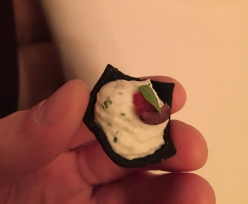 Each staff member seems to have their designated spot, with people stationed at each corner of the room. Everyone keeps busy, keeping a constant watch on every table. For the two of us, we had the attention of five employees throughout the night. It’s not possible to feel neglected.
Each staff member seems to have their designated spot, with people stationed at each corner of the room. Everyone keeps busy, keeping a constant watch on every table. For the two of us, we had the attention of five employees throughout the night. It’s not possible to feel neglected.
After having the menu options explained to us, we chose the four course meal, consisting of two dishes from the appetizer side, one from the main course, and one dessert. Everything looked
amazing. After placing our orders we were promptly treated to an amuse-bouche of herbed ricotta on a Parmesan cracker. Simple as it sounds, it set the bar for the night, leaving our jaws on the floor out of sheer astonishment at how flavorful it was. The meal 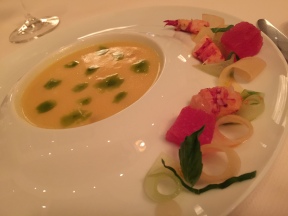 continued with one hit after the other. A second amuse-bouche of carrots prepared three ways, and then our first real course. I started with a melon soup, a cold soup consisting of a melon blend, prawns, lemon coulis, and espelette pepper oil. The prawn was cooked “ishiyaki,” coming out sizzling on a hot stone, carved up and plated tableside. It was as much a show as it was a meal. Attention was paid to every detail. My girlfriend’s seafood salad was held back until mine was plated, at which point they were placed on our table simultaneously. Their
continued with one hit after the other. A second amuse-bouche of carrots prepared three ways, and then our first real course. I started with a melon soup, a cold soup consisting of a melon blend, prawns, lemon coulis, and espelette pepper oil. The prawn was cooked “ishiyaki,” coming out sizzling on a hot stone, carved up and plated tableside. It was as much a show as it was a meal. Attention was paid to every detail. My girlfriend’s seafood salad was held back until mine was plated, at which point they were placed on our table simultaneously. Their  service is down to a science.
service is down to a science.
Next came the gnocchi with chanterelle mushrooms, fava beans, parmesan, and lamb’s quarter and the lobster tail a la plancha. Each subsequent bite was better than the last. We didn’t even feel full till the very end of our meals due to our focusing so much on the flavors. Our main dishes, the suckling pig and Wagyu beef continued to astonish, taking us to our area of expertise, dessert.
 Throughout our meal, as our waitress checked on us and brought us our courses, she had the chance to converse a bit. She asked us if we were celebrating anything special, to which we explained it was a birthday dinner. We also took the time to tell her we were both pastry students at The CIA, and were incredibly impressed with our meal. She took our order of the Kidavoa (Madagascar Cacao, Selim pepper chocolate sable , star anise caramel ice cream, and banana – lime confit mousse), and the Bolivie
Throughout our meal, as our waitress checked on us and brought us our courses, she had the chance to converse a bit. She asked us if we were celebrating anything special, to which we explained it was a birthday dinner. We also took the time to tell her we were both pastry students at The CIA, and were incredibly impressed with our meal. She took our order of the Kidavoa (Madagascar Cacao, Selim pepper chocolate sable , star anise caramel ice cream, and banana – lime confit mousse), and the Bolivie  (chocolate dentelle, cru savage bavaroise, roasted cocoa nib, ma khan berry ice cream, and smoked Mexican vanilla – chocolate cremeux). When she arrived back at our table with our order, she presented us with a third plate of the Rhubarbe dessert, explaining that the chef wanted to give us a taste of one of their fruit options, as we had both ordered chocolate. The plate was also inscribed with a chocolate “Happy Birthday” and was adorned with a white chocolate birthday candle. It was an incredibly kind gesture and a perfect example of hospitality at its finest. At the conclusion of our meal, we were given
(chocolate dentelle, cru savage bavaroise, roasted cocoa nib, ma khan berry ice cream, and smoked Mexican vanilla – chocolate cremeux). When she arrived back at our table with our order, she presented us with a third plate of the Rhubarbe dessert, explaining that the chef wanted to give us a taste of one of their fruit options, as we had both ordered chocolate. The plate was also inscribed with a chocolate “Happy Birthday” and was adorned with a white chocolate birthday candle. It was an incredibly kind gesture and a perfect example of hospitality at its finest. At the conclusion of our meal, we were given 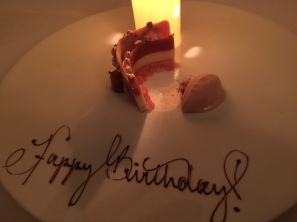 an assortment of petit four, consisting of fresh madeleines, mini tarts, and chocolates as well as personalized printed birthday menus containing every item we ordered. It was a wonderful way to commemorate an exceptional meal. As we prepared to leave, our waitress approached us to let us know we should stick around, as the Maitre D’ wanted to give us a tour of the kitchen. We graciously accepted the offer and remained seated.
an assortment of petit four, consisting of fresh madeleines, mini tarts, and chocolates as well as personalized printed birthday menus containing every item we ordered. It was a wonderful way to commemorate an exceptional meal. As we prepared to leave, our waitress approached us to let us know we should stick around, as the Maitre D’ wanted to give us a tour of the kitchen. We graciously accepted the offer and remained seated.
When he arrived, he greeted us with a handshake and asked about our education. We explained where we stood in the program as he led us to the back. Seeing a Michelin kitchen in action was an eye opening experience. It peels back the layers and lets you see where the magic lay, in the hands of the cooks. We were brought station to station, and given a rundown of their production. It was truly the perfect way to cap off an unbelievable experience.
I left the restaurant in awe. Both my dining companion and I giddily walked back to Grand Central, recounting the dreamlike night we had just had the pleasure of enjoying. It set the bar for what we could attain. This is what we are capable of. This is the standard that we have to hold ourselves to. I had never experienced anything quite like this, and I hope it won’t be the last. It was the perfect way to celebrate, and I am incredibly grateful for this opportunity. I eagerly await the next time I will be able to visit again.
The Contemporary Cake
 Flavor is perceived differently by everyone. It’s one of the things that makes food so cool. In the same way art is subjective, people have different food preferences. Something that could taste terrible to one person may be another’s favorite treat.
Flavor is perceived differently by everyone. It’s one of the things that makes food so cool. In the same way art is subjective, people have different food preferences. Something that could taste terrible to one person may be another’s favorite treat.
Flavors and the way they work together were a huge component of my most recent completed course, contemporary cakes. Each class, we would build entremets (cakes consisting of numerous layers of custards, creams, cakes, and mousses.) Each layer had to work with the rest to create a unified flavor. Interestingly enough this sometimes included flavors that you would never dream of incorporating in desserts to enhance undertones in components you never knew existed.
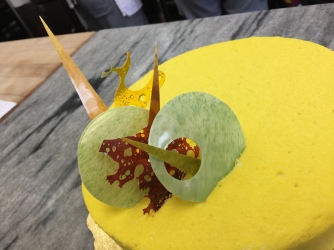 One cake in particular consisted of blueberry compote, basil cremeux, and lemon mousse. The addition of basil was something I would consider relatively outside the box, but it fit perfectly with the flavor profile. When you break the cake down layer by layer, you can see these sort of flavor crossovers. By this, I mean lemon works with basil, which in turn works with blueberry. Everything in the cake works with another component making for a well-balanced dessert.
One cake in particular consisted of blueberry compote, basil cremeux, and lemon mousse. The addition of basil was something I would consider relatively outside the box, but it fit perfectly with the flavor profile. When you break the cake down layer by layer, you can see these sort of flavor crossovers. By this, I mean lemon works with basil, which in turn works with blueberry. Everything in the cake works with another component making for a well-balanced dessert.
Each cake was expertly crafted with this in mind, utilizing different mousse techniques while teaching us efficient production methods to ensure a perfect product. We were also required to conceptualize our finished products in advance of class, giving us our first real opportunity to customize the design of our products.
 The final project of our class had us create cakes of our very own, designed around an assigned flavor profile. Each cake had to have at least five layers, two of which had to be the assigned flavor. My group was assigned blueberry, which we utilized as both an insert and exterior mousse.
The final project of our class had us create cakes of our very own, designed around an assigned flavor profile. Each cake had to have at least five layers, two of which had to be the assigned flavor. My group was assigned blueberry, which we utilized as both an insert and exterior mousse.
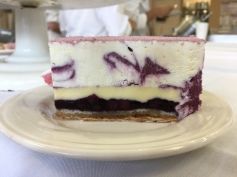 Trying to make it as interesting and varied as possible, we designed a cake consisting of puff pastry, marmalade, buttermilk cake, blueberry-lavender compote, ginger-orange cremeux, and blueberry-cream cheese mousse. We named it “Violet Bauregarde” after the character from Roald Dahl’s classic novel, Charlie and the Chocolate Factory. Much to my delight, my cake was one of the best received in the class. I (very happily) took half of it home to show off to my family. We finished off the class producing and serving desserts for the AOS graduation.
Trying to make it as interesting and varied as possible, we designed a cake consisting of puff pastry, marmalade, buttermilk cake, blueberry-lavender compote, ginger-orange cremeux, and blueberry-cream cheese mousse. We named it “Violet Bauregarde” after the character from Roald Dahl’s classic novel, Charlie and the Chocolate Factory. Much to my delight, my cake was one of the best received in the class. I (very happily) took half of it home to show off to my family. We finished off the class producing and serving desserts for the AOS graduation.
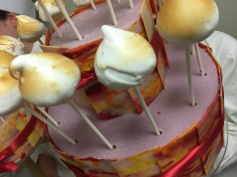 Contemporary cakes was a step up in intensity from the last two classes I’ve taken since coming back from externship. I feel like it really got me re-acclimated to the production environment and strengthened my flavor pairing and entremet production skills. With this class completed, I am down to the final 6 months at the CIA. It’s been an incredible journey thus far, and I can’t wait to see what it has left in store for me. Till then, I’ll be bringing it.
Contemporary cakes was a step up in intensity from the last two classes I’ve taken since coming back from externship. I feel like it really got me re-acclimated to the production environment and strengthened my flavor pairing and entremet production skills. With this class completed, I am down to the final 6 months at the CIA. It’s been an incredible journey thus far, and I can’t wait to see what it has left in store for me. Till then, I’ll be bringing it.
“We are the music makers, and we are the dreamers of dreams.”
 There’s something to be said about the effectiveness of simplicity in sweets. The more complex something is, the more likely it is that all the components will blend together into some sort of indistinguishable blob of sugar. Chocolates are straight to the point. Through chemistry, you are allowed near limitless options to create amazing sweets using just a few ingredients at a time
There’s something to be said about the effectiveness of simplicity in sweets. The more complex something is, the more likely it is that all the components will blend together into some sort of indistinguishable blob of sugar. Chocolates are straight to the point. Through chemistry, you are allowed near limitless options to create amazing sweets using just a few ingredients at a time
 Walking into class the first day, our chef (one of my favorites we’ve had thus far) exclaimed that the class wasn’t so much about chocolates as it was about crystallization. This statement proved true, as the next few weeks were packed full of the most academically heavy content we’ve seen in the kitchen up to this point. Discussing the various crystallization processes involved in chocolate and candy making, we covered ganaches, confections of crystalline and non crystalline varieties, jelled candies, and shell molded chocolates. In addition to all of this information, I walked away with another thing…… a reinforced love of chocolates.
Walking into class the first day, our chef (one of my favorites we’ve had thus far) exclaimed that the class wasn’t so much about chocolates as it was about crystallization. This statement proved true, as the next few weeks were packed full of the most academically heavy content we’ve seen in the kitchen up to this point. Discussing the various crystallization processes involved in chocolate and candy making, we covered ganaches, confections of crystalline and non crystalline varieties, jelled candies, and shell molded chocolates. In addition to all of this information, I walked away with another thing…… a reinforced love of chocolates.
 I can say with a fair bit of certainty that I am not the strongest in the kitchen. In all honesty, I find it to be a stressful and alien environment. This class was the first time it felt right. Chocolate isn’t for everyone. It is difficult to work with and can at times, be an extremely frustrating medium to tackle. At the same time, it is very structured. There is a right way and a wrong way to do things, and that’s something I find comfort in. It is as simple as “if you do not follow the rules, your product does not turn out.” This is true in baking as well, but there is definitely a little bit more leeway and wiggle room to work.
I can say with a fair bit of certainty that I am not the strongest in the kitchen. In all honesty, I find it to be a stressful and alien environment. This class was the first time it felt right. Chocolate isn’t for everyone. It is difficult to work with and can at times, be an extremely frustrating medium to tackle. At the same time, it is very structured. There is a right way and a wrong way to do things, and that’s something I find comfort in. It is as simple as “if you do not follow the rules, your product does not turn out.” This is true in baking as well, but there is definitely a little bit more leeway and wiggle room to work.
 In addition to its structure, there are far fewer ingredients to work with, making production a far more streamlined process. Through slight variations, you can alter the product drastically. It becomes more about mastering technique than anything else. It’s minimal in its equipment requirements as well. I am currently in the contemporary cakes class, which requires the use of every tool in our kit. For chocolates, I didn’t need any more than 3 tools. As long as you know how to use the material, it is an extremely clean process.
In addition to its structure, there are far fewer ingredients to work with, making production a far more streamlined process. Through slight variations, you can alter the product drastically. It becomes more about mastering technique than anything else. It’s minimal in its equipment requirements as well. I am currently in the contemporary cakes class, which requires the use of every tool in our kit. For chocolates, I didn’t need any more than 3 tools. As long as you know how to use the material, it is an extremely clean process.
 The Chef is definitely one of the top I have worked with at the school. He is honest, brutally so at times, but a master of the subject and an excellent teacher. You put the effort in and show him the respect he deserves, and he’ll show you respect in return. He tells you when things are trash and acknowledges when things are good. Above all else, he knows he is an educator. In his opening lecture, he gave us a speech about how many chefs don’t realize they aren’t chefs anymore once they become teachers. This is something I have come across far too frequently during my time at The CIA. I am here to learn how to produce things. This requires production pace to be slower than it is in the real world, and that’s something many teachers have yet to grasp (despite years on staff). We pay to learn, not to be yelled at for working too slow. In chocolates, we were graded less on the final product, and more on how we worked throughout the class. I have great respect for the teacher, and would love the opportunity to take another class with him.
The Chef is definitely one of the top I have worked with at the school. He is honest, brutally so at times, but a master of the subject and an excellent teacher. You put the effort in and show him the respect he deserves, and he’ll show you respect in return. He tells you when things are trash and acknowledges when things are good. Above all else, he knows he is an educator. In his opening lecture, he gave us a speech about how many chefs don’t realize they aren’t chefs anymore once they become teachers. This is something I have come across far too frequently during my time at The CIA. I am here to learn how to produce things. This requires production pace to be slower than it is in the real world, and that’s something many teachers have yet to grasp (despite years on staff). We pay to learn, not to be yelled at for working too slow. In chocolates, we were graded less on the final product, and more on how we worked throughout the class. I have great respect for the teacher, and would love the opportunity to take another class with him.
Chocolates was my favorite class. I learned a ton of information that will certainly be of use to me both personally and professionally. For anyone taking this class in the future, do the reading, be prepared, volunteer to answer questions, and work hard. Keep it clean, keep it professional, and enjoy yourself .
The Art Of Decor
 The ticking on of time is something that looms heavy in the bakery. If you mix something too long, you ruin it. If you bake something too long, you ruin it. If you try to crank up the heat on the stove, chances are you’ll ruin it. And above all else, if you miss a deadline, you’ll ruin it. If you need to have a wedding cake somewhere at a certain time you better make it or you’re finished. In a business that’s based largely on word of mouth, one negative experience could potentially cost you a dozen clients.
The ticking on of time is something that looms heavy in the bakery. If you mix something too long, you ruin it. If you bake something too long, you ruin it. If you try to crank up the heat on the stove, chances are you’ll ruin it. And above all else, if you miss a deadline, you’ll ruin it. If you need to have a wedding cake somewhere at a certain time you better make it or you’re finished. In a business that’s based largely on word of mouth, one negative experience could potentially cost you a dozen clients.
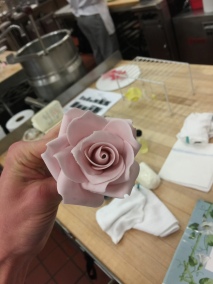 I’ve now completed my course in Confections and Special Occasion Cakes and will be starting up Chocolates and Confections this week (yay!). As a chocoholic, I’d be surprised if anything could sway my opinion towards the negative in that class, but I can’t say the same for Confectionary Arts and Special Occasion Cakes. It wasn’t a bad class by any means. The Chef was awesome, and I am proud of the projects I produced.
I’ve now completed my course in Confections and Special Occasion Cakes and will be starting up Chocolates and Confections this week (yay!). As a chocoholic, I’d be surprised if anything could sway my opinion towards the negative in that class, but I can’t say the same for Confectionary Arts and Special Occasion Cakes. It wasn’t a bad class by any means. The Chef was awesome, and I am proud of the projects I produced.
This second “year” of school, though young, is definitely more specialized than the first. Where as year one, each class sort of built on to the previous one and focused on baking and production, year two is, at this point, all about new and unfamiliar mediums and techniques. If everything continues as it has so far, this is where you really start to find your niche.
 In terms of the Confectionary and Special Occasion Cakes class, I didn’t really take to it. Building the large cakes was fun, and utilizing the available decorations to enhance the products was awesome, but taking the time to make little detailed decorations like gum paste flowers felt like a chore. It takes up so much time for such a little detail I find it hard to justify not utilizing pre made décor for cakes. It’s very interesting learning the proper construction techniques of these pieces, but I don’t see myself using them very frequently in the future. It certainly wasn’t what I would consider fun, but others in the class loved and excelled at it.
In terms of the Confectionary and Special Occasion Cakes class, I didn’t really take to it. Building the large cakes was fun, and utilizing the available decorations to enhance the products was awesome, but taking the time to make little detailed decorations like gum paste flowers felt like a chore. It takes up so much time for such a little detail I find it hard to justify not utilizing pre made décor for cakes. It’s very interesting learning the proper construction techniques of these pieces, but I don’t see myself using them very frequently in the future. It certainly wasn’t what I would consider fun, but others in the class loved and excelled at it.
 Towards the end of the class we made large wedding cakes with a partner, which allowed us to divide the labor and handle different aspects of the production. While I was in charge of the larger blanket aspects of the cake such as fondant and royal icing, my partner volunteered to take on the task of the gum paste decor, which she completed with dazzling results. This division allowed us to complete a breathtaking final product, which we were proud to display in the class.
Towards the end of the class we made large wedding cakes with a partner, which allowed us to divide the labor and handle different aspects of the production. While I was in charge of the larger blanket aspects of the cake such as fondant and royal icing, my partner volunteered to take on the task of the gum paste decor, which she completed with dazzling results. This division allowed us to complete a breathtaking final product, which we were proud to display in the class.
When it came to the individual tiered cakes, we were given free range to decorate as we pleased. This allowed us to kind of work with the techniques we felt most comfortable with in the class, ensuring our cakes turned out the best they could be. I chose to focus on chocolate and fondant work, and based my decor on the film Black Swan (something I had been planning to do since learning of this class on my first tour of the school a few years back.)

Although it wasn’t my favorite class I have taken at The Culinary, I appreciate the experience and the knowledge I walked away with. Next up is Chocolates class and I cant be any more excited! Time to bring it!